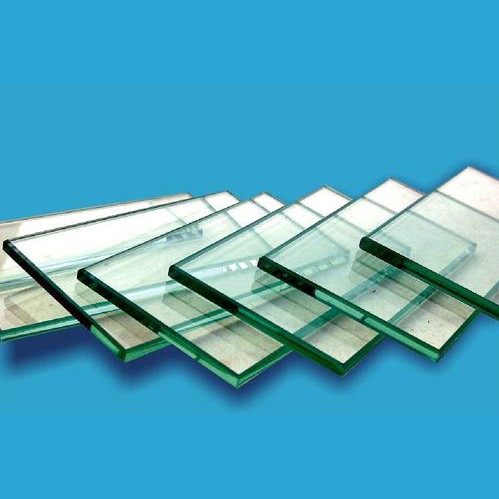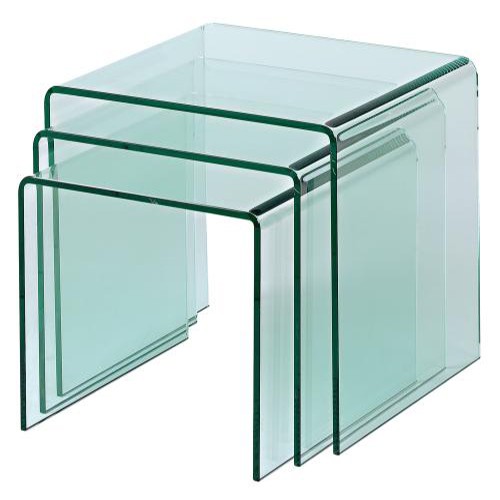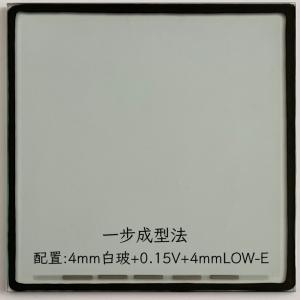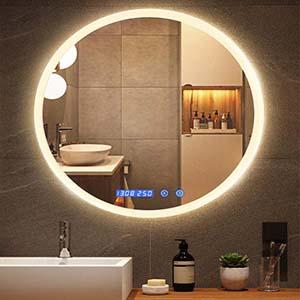Description
Top quality tempered glass manufacturer in China HG-T01


| Glass Type | Clear Glass, Tinted Glass, Reflective Glass, |
| On-line Low-e Glass, Low-iron Glass | |
| Craft | Tempered Glass, Heat Strength Glass, |
| Heat Soaked Glass | |
| Color | Blue, Green, Bronze, Gray,Golden etc. |
| Thickness | 5mm、6mm、8mm、10m |
| m12mm、15mm、19mm | |
| Max Size | Flat Glass:2440*6000mm |
| Curved Glass:1000x2000mm | |
| Min Size | Flat Glass:300x300mm |
| Curved Glass:300*300mm | |
| Certificates | CE & CCC & CSI |
Why choose us:
1. Can accept small quantity order
2. Accept customized
3. Handle optional
4. Towel rack optional (with/without)
5. Glass self-cleaning (more selling points)
6. Contains installation hardware (convenient installation and more thoughtful)
7, with installation instructions (conform European and American habits)
8. Square tube/round tube/stainless steel/wire drawing and gloss (more abundant products)
9. Carton packaging (Both project and supermarket)
1. Production process
Cutting-edging-rounded corners-water jet-punching-silk screen-tempering-self-cleaning liquid / safety explosion-proof film-packaging
Cut Two edges grinding


Round Corner Machine hole puncher


curve tempered glass Bathroom door


Glass film

Nano self-cleaning liquid
2. Quality Control
2.1 Each glass must be inspected to confirm before entering the factory;

2.2 Quality control in the production process are in accordance with quality control standards.
First inspection-self-inspection-special inspection-factory inspection, product standards are strictly implemented in accordance with customer technical documents or industry standards;
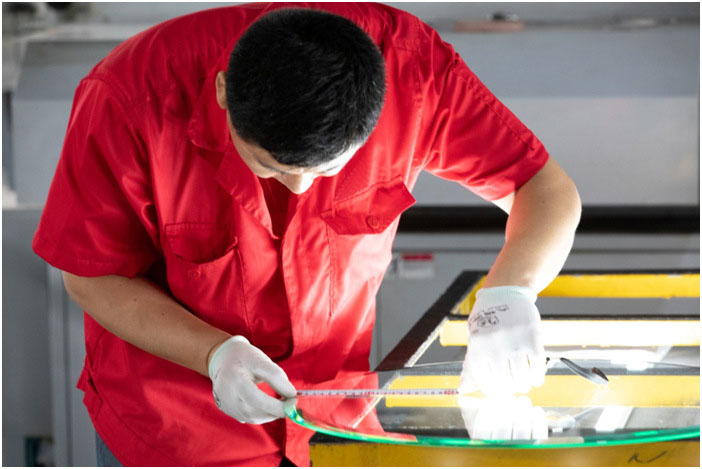
2.3 The dimensional accuracy and tempering quality inspection data of processed products shall be recorded and archived with traceability;
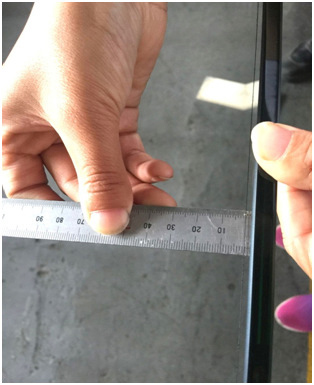
2.4 The bending degree of toughened grain is tested, the bending degree is 1.5‰, and the grain size is 55-80 grains per 50*50mm

3. The company's certification qualifications
The company's products have passed European CE certification and American SGCC certification
4. 10years of export packaging experience: Carton foam packaging and fumigation-free wooden box packaging can be realized to ensure product transportation safety;

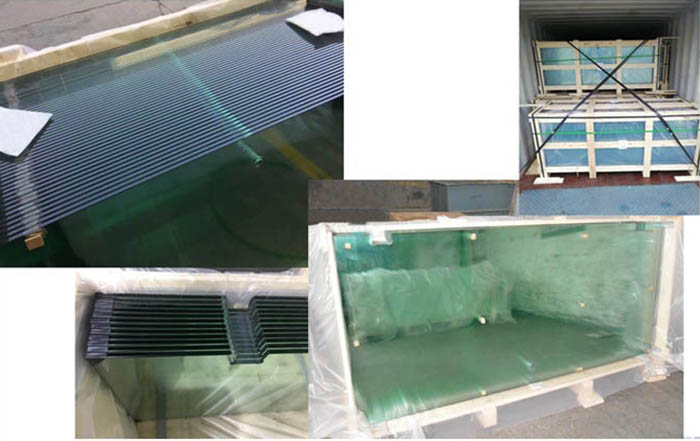
5. The company's equipment processing capacity
Focus on the manufacture of tempered glass for home appliances for 14 years. The company has comprehensive equipment capabilities for processing high-temperature silk screens, including Italian Bottero cutting machines, Bottero edging machines, CNC machining centers, automatic punching machines, automatic rounding machines, automatic screen printing machines, tempering furnaces and other equipment.
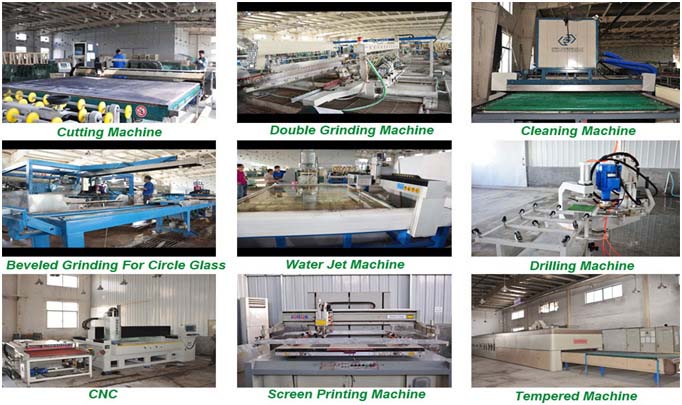
-Choose Taiwan Glass or Jinjing Automotive Grade Original Float glass
-Polished straight edges, size tolerance ±1mm, uniform edge 1mm
-Safety corner or round corner treatment
-Water jet cutting, accurate size, vertical water jet with safety angle,
-Even tempered grain
-Fumigation-free wooden box packaging, firm and safe
-Can provide carton foam sales packaging
-Self-cleaning nano coating can be applied
-Safety explosion-proof film can be attached

Glass processing range:
Thickness: 3mm, 3.2mm, 4mm, 5mm, 6mm, 8mm, 10mm, 12mm
Glass color: chear glass, ultra clear glass, tinted glass,reflective glass
Edging: straight edge, round edge
Tempering: C shape and J shape
Silk screen: high temperature screen printing, frosted screen printing
shower room: shower room assembly
Other processes: can be coated with nano self-cleaning liquid (from Germany, 10-year warranty),
Safety explosion-proof film can be attached
Packing: plywood wooden box and carton + foam separate sales packaging
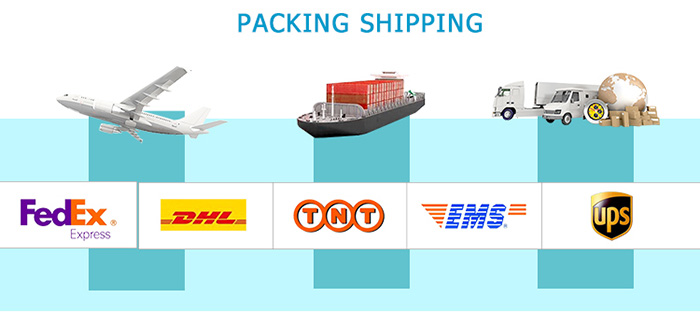
The Role of Safety Glass in Modern Architecture
Safety glass has become a cornerstone in modern architecture, revolutionizing the way buildings are designed and constructed. Its unique properties—strength, durability, and aesthetic versatility—make it an essential material for contemporary architectural projects. This article explores the various applications of safety glass in modern architecture, its benefits, and the technological advancements that have enhanced its performance and utility.
Types of Safety Glass
There are several types of safety glass used in modern architecture, each with specific properties and applications:
Tempered Glass: Also known as toughened glass, tempered glass is heated to high temperatures and then rapidly cooled. This process increases its strength and ensures that it breaks into small, blunt pieces, reducing the risk of injury.
Laminated Glass: Composed of two or more layers of glass with an interlayer of plastic (usually polyvinyl butyral or ethylene-vinyl acetate), laminated glass holds together when shattered. This characteristic makes it ideal for applications requiring impact resistance and security.
Fireproof Glass: Designed to withstand high temperatures and prevent the spread of flames and smoke, fireproof glass is crucial for ensuring safety in case of a fire.
Bulletproof Glass: Made from multiple layers of laminated glass and polycarbonate, bulletproof glass is used in high-security areas to provide protection against ballistic attacks [6].
Applications in Modern Architecture
Exterior Facades
Safety glass is extensively used in the exterior facades of buildings. Modern skyscrapers and office buildings often feature large glass facades that provide a sleek and contemporary look. Laminated and tempered glass are commonly used for these applications due to their strength and ability to provide thermal insulation, sound reduction, and impact resistance. These glass facades not only enhance the aesthetic appeal of buildings but also improve energy efficiency by allowing natural light to penetrate deep into the interior spaces [1].
Windows and Doors
Windows and doors made from safety glass offer enhanced security and energy efficiency. Tempered glass is particularly popular for sliding doors and large windows because of its ability to withstand impact and its resistance to breaking. Laminated glass, with its added security benefits, is often used in windows and doors in areas prone to natural disasters or for added protection against forced entry [2].
Balconies and Staircases
Glass balconies and staircases are popular in modern architectural designs for their ability to create a sense of openness and continuity. Tempered glass is typically used for these applications due to its strength and safety characteristics. Glass railings, in particular, offer unobstructed views and add a touch of elegance to residential and commercial buildings alike [3].
Partitions and Interior Walls
Interior glass partitions and walls made from safety glass are increasingly being used in office buildings, hotels, and homes. These glass elements allow for the creation of open, flexible spaces that can be easily reconfigured. Laminated glass is often used for interior partitions because it provides sound insulation and privacy while maintaining an open and airy feel. Additionally, decorative laminated glass with colored interlayers or patterns can add a unique aesthetic to interior spaces [3].
Skylights and Roofs
Skylights and glass roofs are another area where safety glass is widely used. These elements bring natural light into buildings, reducing the need for artificial lighting and enhancing the occupants' well-being. Laminated glass is preferred for skylights and roofs because it stays intact when shattered, preventing debris from falling into the building. Additionally, laminated glass can be treated to provide UV protection and improve thermal performance [4].
Fire-Resistant Applications
Fireproof glass is essential in buildings that require strict fire safety standards. It is used in fire doors, partitions, and windows to prevent the spread of flames and smoke during a fire. Fireproof glass can withstand high temperatures for extended periods, providing crucial time for occupants to evacuate safely and for firefighters to control the blaze. This type of glass is an integral part of fire-rated assemblies that enhance the overall safety of modern buildings [5].
Benefits of Safety Glass in Architecture
Enhanced Safety and Security
The primary benefit of safety glass is its ability to enhance the safety and security of buildings. Tempered glass reduces the risk of injury by breaking into small, blunt pieces, while laminated glass holds together when shattered, providing a barrier against intrusion and debris. Fireproof glass helps contain fires, preventing them from spreading and providing a safe evacuation route [6].
Aesthetic Versatility
Safety glass offers architects and designers unparalleled aesthetic versatility. It can be manufactured in various colors, patterns, and finishes, allowing for creative and innovative designs. The transparency of glass also helps create a sense of openness and connectivity between indoor and outdoor spaces, enhancing the overall aesthetic appeal of buildings [1].
Energy Efficiency
Modern safety glass can significantly improve the energy efficiency of buildings. Laminated glass with UV-filtering interlayers reduces heat gain and loss, lowering the need for heating and cooling. Double-glazed tempered glass units provide excellent thermal insulation, helping to maintain comfortable indoor temperatures year-round. These energy-efficient properties contribute to sustainable building practices and reduce the environmental impact of construction [2].
Sound Insulation
Laminated glass provides excellent sound insulation, making it ideal for use in urban environments or buildings located near busy roads and airports. The interlayer in laminated glass dampens sound vibrations, reducing noise transmission and creating a quieter indoor environment. This benefit is particularly important in residential buildings, hotels, and office spaces where a peaceful atmosphere is desired [3].
Technological Advancements
Recent technological advancements have further enhanced the performance and applications of safety glass in architecture. Innovations such as low-emissivity (Low-E) coatings, smart glass, and photovoltaic glass are pushing the boundaries of what is possible with safety glass.
Low-E Coatings: These coatings reflect infrared radiation while allowing visible light to pass through, improving the thermal performance of glass and reducing energy consumption.
Smart Glass: Also known as switchable glass, smart glass can change its transparency in response to electrical signals, providing dynamic control over light and privacy.
photovoltaic glass: This type of glass integrates solar cells, allowing buildings to generate electricity from sunlight while maintaining transparency and aesthetics [1].
Conclusion
Safety glass has become an indispensable material in modern architecture, offering a combination of safety, security, aesthetic appeal, and energy efficiency. Its applications range from exterior facades and windows to interior partitions and fire-resistant installations, demonstrating its versatility and importance in contemporary building design. As technology continues to advance, the role of safety glass in architecture is likely to expand, providing even more innovative and sustainable solutions for the built environment.
 English
English Russian
Russian